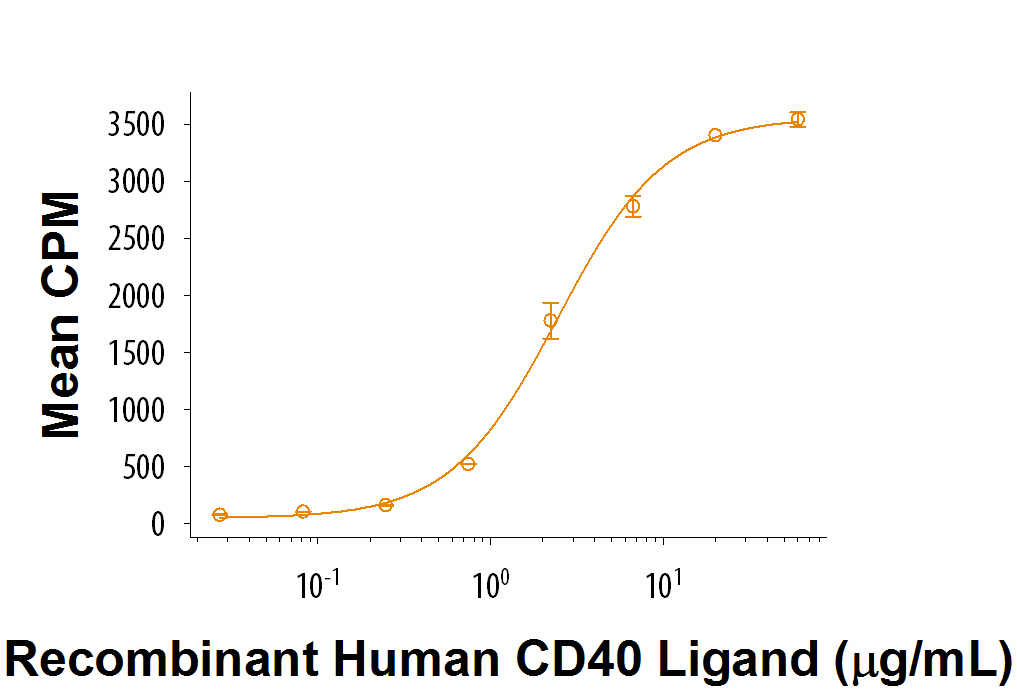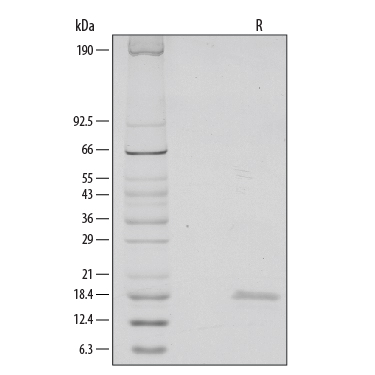Recombinant Human CD40 Ligand/TNFSF5 (aa 108-261) Protein
Recombinant Human CD40 Ligand/TNFSF5 (aa 108-261) Protein Summary
Product Specifications
Glu108-Leu261, with an N-terminal Met
Analysis
Product Datasheets
Carrier Free
CF stands for Carrier Free (CF). We typically add Bovine Serum Albumin (BSA) as a carrier protein to our recombinant proteins. Adding a carrier protein enhances protein stability, increases shelf-life, and allows the recombinant protein to be stored at a more dilute concentration. The carrier free version does not contain BSA.
In general, we advise purchasing the recombinant protein with BSA for use in cell or tissue culture, or as an ELISA standard. In contrast, the carrier free protein is recommended for applications, in which the presence of BSA could interfere.
6245-CL
| Formulation | Lyophilized from a 0.2 μm filtered solution in NaH2PO4, NaCl and EDTA with BSA as a carrier protein. |
| Reconstitution | Reconstitute at 500 μg/mL in PBS containing at least 0.1% human or bovine serum albumin. |
| Shipping | The product is shipped at ambient temperature. Upon receipt, store it immediately at the temperature recommended below. |
| Stability & Storage: | Use a manual defrost freezer and avoid repeated freeze-thaw cycles.
|
6245-CL/CF
| Formulation | Lyophilized from a 0.2 μm filtered solution in Tris-HCL, NaCl and EDTA. |
| Reconstitution | Reconstitute at 500 μg/mL in PBS. |
| Shipping | The product is shipped at ambient temperature. Upon receipt, store it immediately at the temperature recommended below. |
| Stability & Storage: | Use a manual defrost freezer and avoid repeated freeze-thaw cycles.
|
Scientific Data
 View Larger
View Larger
Recombinant Human CD40 Ligand/TNFSF5 (aa 108-261) (Catalog # 6245-CL) stimulates cell proliferation using B cell-enriched peripheral blood mononuclear cells (PBMC) in the presence of IL-4. The ED50 for this effect is 1.00-3.00 µg/mL in the presence of 20 ng/mL of Recombinant Human IL-4 (Catalog # 204-IL).
 View Larger
View Larger
1 μg/lane of Recombinant Human CD40 Ligand/TNFSF5 (aa 108-261) was resolved with SDS-PAGE under reducing (R) conditions and visualized by silver staining, showing a single band at 18 kDa.
Reconstitution Calculator
Background: CD40 Ligand/TNFSF5
Human CD40 LigandCD40 Ligand, also known as TNFSF, CD154, TRAP, and gp39, is a 34-39 kDa type II transmembrane glycoprotein that belongs to the TNF superfamily (1-3). Mature human CD40 Ligand consists of a 22 amino acid (aa) cytoplasmic domain, a transmembrane segment, and an 215 aa extracellular region (4, 5). The extracellular domain of human CD40 Ligand shares 74% and 76% aa sequence identity with mouse and rat CD40 Ligand, respectively. Similar to other TNF superfamily members, CD40 Ligand forms a bioactive homotrimer, both as membrane bound and soluble forms (6-9). The 18 kDa soluble form (aa 113-261) arises from proteolytic processing. Mutation and alternative splicing generate additional forms of CD40 Ligand that are often truncated or non-trimerizable (8). CD40 Ligand is expressed on platelets, as well as on activated T cells and B cells, basophils, eosinophils, fibroblasts, mast cells, monocytes, natural killer cells, vascular endothelial cells, and smooth muscle cells. CD40 Ligand binds to CD40, which is expressed on the surface of B cells, dendritic cells, macrophages, monocytes, platelets, endothelial, and epithelial cells (10). The interaction of CD40 Ligand with CD40 initiates signaling in both CD40 and CD40 Ligand expressing cells (11). CD40 ligation by CD40 Ligand promotes B cell activation and T cell-dependent humoral responses (12, 13). CD40 Ligand dysregulation on T cells and antigen presenting cells contributes to the immune deficiency associated with HIV infection and AIDS (14, 15). It is also implicated in the pathology of multiple cardiovascular diseases including atherosclerosis, atherothrombosis, and restenosis (16, 17).
- Zhang, G. (2004) Curr. Opin. Struct. Biol. 14:154.
- Hehlgans, T. and K. Pfeffer (2005) Immunology 115:1.
- Quezada, S.A. et al. (2004) Annu. Rev. Immunol. 22:307.
- Graf, D. et al. (1992) Eur. J. Immunol. 22:3191.
- Hollenbaugh, D. et al. (1992) EMBO J. 11:4313.
- Khandekar, S.S. et al. (2001) Protein Expr. Purif. 23:301.
- Pietravalle, F. et al. (1996) J. Biol. Chem. 271:5965.
- Garber, E. et al. (1999) J. Biol. Chem. 274:33545.
- Vakkalanka, R.K. et al. (1999) Arthritis Rheum. 42:871.
- van Kooten, C. and J. Banchereau (1997) Curr. Opin. Immunol. 9:330.
- Eissner, G. et al. (2004) Cytokine Growth Factor. Rev. 15:353.
- Rickert, R.C. et al. (2011) Immunol. Rev. 244:115.
- Elgueta, R. et al. (2009) Immunol. Rev. 229:152.
- Kornbluth, R.S. (2000) J. Leukoc. Biol. 68:373.
- Chougnet, C. (2003) J. Leukoc. Biol. 74:702.
- Pamukcu, B. et al. (2011) Ann. Med. 43:331.
- Hassan, G.S. et al. (2012) Immunobiology 217:521.
Citations for Recombinant Human CD40 Ligand/TNFSF5 (aa 108-261) Protein
R&D Systems personnel manually curate a database that contains references using R&D Systems products. The data collected includes not only links to publications in PubMed, but also provides information about sample types, species, and experimental conditions.
7
Citations: Showing 1 - 7
Filter your results:
Filter by:
-
Truncated-semaphorin3A is a potential regulatory molecule to restore immune homeostasis in immune-mediated diseases
Authors: N Eiza, O Kessler, A Sabag, G Neufeld, EY Jones, Z Vadasz
Frontiers in Pharmacology, 2023-01-10;13(0):1085892.
Species: Human
Sample Types: Whole Cells
Applications: Cell Culture -
B cell-intrinsic changes with age do not impact antibody-secreting cell formation but delay B cell participation in the germinal centre reaction
Authors: JL Lee, SC Fra-Bido, AR Burton, S Innocentin, DL Hill, MA Linterman
Aging Cell, 2022-08-18;0(0):e13692.
Species: Human
Sample Types: Whole Cells
Applications: Stimulation -
Regulation of B cell functions by S-nitrosoglutathione in the EAE model
Authors: J Kim, SMT Islam, F Qiao, AK Singh, M Khan, J Won, I Singh
Redox Biology, 2021-06-23;45(0):102053.
Species: Mouse
Sample Types: Whole Cells
Applications: Bioassay -
Modular expression analysis reveals functional conservation between human Langerhans cells and mouse cross-priming dendritic cells.
Authors: Artyomov M, Munk A, Gorvel L, Korenfeld D, Cella M, Tung T, Klechevsky E
J Exp Med, 2015-04-27;212(5):743-57.
Species: Human
Sample Types: Whole Cells
Applications: Bioassay -
Characterization of platelet-monocyte complexes in HIV-1-infected individuals: possible role in HIV-associated neuroinflammation.
Authors: Singh, Meera V, Davidson, Donna C, Jackson, Joseph W, Singh, Vir B, Silva, Jharon, Ramirez, Servio H, Maggirwar, Sanjay B
J Immunol, 2014-04-11;192(10):4674-84.
Species: Human
Sample Types: Whole Blood
Applications: Bioassay -
IL-27 in human secondary lymphoid organs attracts myeloid dendritic cells and impairs HLA class I-restricted antigen presentation.
Authors: Morandi, Fabio, Di Carlo, Emma, Ferrone, Soldano, Petretto, Andrea, Pistoia, Vito, Airoldi, Irma
J Immunol, 2014-02-19;192(6):2634-42.
Species: Human
Sample Types: Whole Cells
Applications: Bioassay -
IL-26 Is Overexpressed in Rheumatoid Arthritis and Induces Proinflammatory Cytokine Production and Th17 Cell Generation.
Authors: Corvaisier M, Delneste Y, Jeanvoine H, Preisser L, Blanchard S, Garo E, Hoppe E, Barre B, Audran M, Bouvard B, Saint-Andre J, Jeannin P
PLoS Biol, 2012-09-25;10(9):e1001395.
Species: Human
Sample Types: Whole Cells
Applications: Bioassay
FAQs
No product specific FAQs exist for this product, however you may
View all Proteins and Enzyme FAQsReviews for Recombinant Human CD40 Ligand/TNFSF5 (aa 108-261) Protein
Average Rating: 5 (Based on 1 Review)
Have you used Recombinant Human CD40 Ligand/TNFSF5 (aa 108-261) Protein?
Submit a review and receive an Amazon gift card.
$25/€18/£15/$25CAN/¥75 Yuan/¥2500 Yen for a review with an image
$10/€7/£6/$10 CAD/¥70 Yuan/¥1110 Yen for a review without an image
Filter by:


